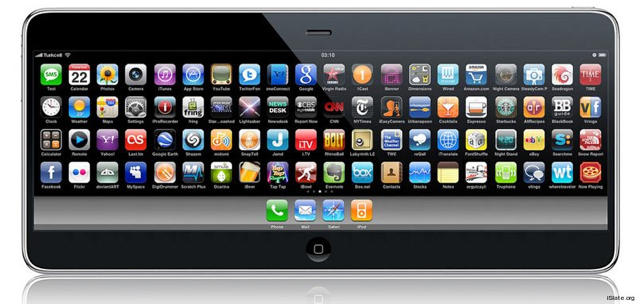Well, it’s finally here: Tablet Week. Or, as I like to think of it, it’s time for there to be Just One More Thing. We all know how significant we expect this announcement to be. A major new advancement in computing, a killer device for a market that has failed time after time, and, just maybe, the last great breakthrough product of Steve Jobs’s amazing career.
All will be revealed on Wednesday, but since we’ve got to something in the interceding 60 hours, I’ve decided to go all in and actually make some bets on killer features for the Apple Tablet With No Name. They’re my best guess based on what we know about the existing tablet and eReader markets, soon-to-launch technologies, and past actions of Apple itself. I haven’t touched one, I haven’t talked to anyone who has, and the Apple employees I’ve seen in the last few weeks are people who know even less about the big secret project than I do.
Probably the biggest question on everyone’s mind is what operating system will power Apple’s tablet of the future, with the leading candidates being Mac OS X and iPhone OS. The more I’ve thought about it, neither is perfectly suited to running such a device, which will be more focused on content creation than the iPhone but less so than the Mac. I’m therefore willing to say that the Tablet is a lock to get its own user interface built on top of core OS X technologies. It will be heavily gesturally driven (yes, even more so than the iPhone), and have far more precise sensing than the current iPhone screen. That said, this UI will more closely resemble the iPhone in look and functionality than it will Snow Leopard. Multitasking is still of less overall utility on a purely touch device than it is on one with a keyboard and mouse combo, so expect full-screen applications, no overlapping windows and possibly iPhone apps that run as widgets on a Dashboard.
A Novel Processor Will Run the Show, but the Screen Will Be a Standard LCD
Like a few other people, I believe that the Tablet will be Apple’s first product running on a processor designed by PA Semi, the Silicon Valley start-up it purchased a few years back to make what Steve Jobs described as “Systems-on-Chips for iPhones and iPods”. Those promised products haven’t arrived yet, but they’re a solid bet to here, as the demands of the device are different from just about anything else on the market. Expect tremendous power per watt, and excellent battery life beyond anything Intel’s Atom has shown so far. Don’t look for anything else exotic, however. This will have a standard LCD screen, not a Pixel Qi, AMOLED, or something more exciting like a shape-shifting screen that develops tactile keys when you type. On such a risky device as this, Apple will use safe technologies wherever it’s possible to.
Expect a 10-inch Tablet Computer, Not an Over-Sized iPhone
Steve Jobs has said it again and again — he only allows Apple to make devices that make sense to him. For that reason, he wouldn’t make a 5″ iPhone or even a 7″ one — they wouldn’t have obvious clear advantages over the 3.1″ model I have today. At 10″, far more complex gestures become possible, and new kinds of content becomes appealing and accessible. This will be netbook-sized in surface area, but probably even thinner than an iPhone. If looking for industrial design inspiration, see the screen of a current generation MacBook. Pull one off its hinges, shrink it by 25 percent, and you’ve got what this will look like.
The Tablet Loves Books, Magazines, and the Internet, but it Won’t Have Mobile Broadband
The best feature of the Amazon Kindle is its always-on, near-unlimited use 3G data plan included in the purchase price. It is the single differentiator that has allowed the Kindle to get traction when many well-conceived eReaders have flopped out of the gate, allowing mobile purchases of books anywhere you go. Unfortunately, the Tablet will not have built-in 3G (nor LTE, for those wondering). The reason the broadband link works on the Kindle is that the device’s black-and-white eInk screen isn’t suited for anything except reading text. No one’s hitting up YouTube or Hulu on a Kindle. The Apple Tablet, by contrast, will be in full-color and ready to tackle everything in the way of media consumption. Movies, TV, magazines, newspapers, the Web, and video games. No one wants another data plan, so I’m afraid this will be 802.11n only for the first generation. I do believe an LTE version will ship in 2011, but even Verizon’s network is too small to justify that kind of expense in what is sure to be a spendy product already.
The Headline Here is Production, Not Consumption
Quite simply, the iPhone is one of the greatest entertainment devices ever created. Whether video, music, RSS reading, or games, it really does it all in a compelling fashion. In fact, it’s only evens light blindspot is as a book replacement, where the small screen gets a bit tiring on the eyes over time. But for all the attention lavished on the New York Times and Wired as they’ve flirtatiously hinted they were the reason that Apple was making a Tablet at all, they’re not the story. While the Tablet will have a great publications store for purchasing fantastically formatted magazines and newspapers, the actual focus of the Tablet is on creativity. With a 10″ screen, there’s ample room for this to be a true magic window, accepting a wide variety of finger paints, vector drawings, photo album layouts, movie editing, song recording and more. Apple doesn’t want to replace your computer, your phone, or your media player.
They want to replace the notebook you doodle in.



